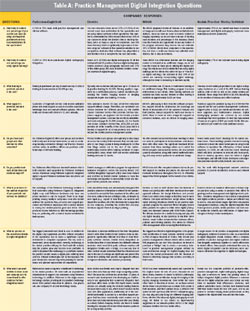A Subjective Overview of Digital Integration
Claudio M. Levato, DDS
Digital integration is a topic about which I am very familiar. Although I have been writing about it since 1995, I am still asked to pen some brilliant thoughts on the subject. So, it surprises me that, over the last decade, we haven’t seen a more dramatic increase in the incorporation of digital imaging—or technology in general—into dental practice.
As I pondered why, and how best to go about finding the answers to this question, my first thoughts took me back to my initial introduction to digital radiology. I was taking C3 (third level) at the Pankey Institute in 1991, where they had a TROPHY digital radiography system. It allowed us to take digital x-rays without film, view them immediately, and then print them out on thermal paper. This experience was as exciting for me as it must have been for Professor G.C. Roentgen in 1895, when he observed the transparent image of his hand that introduced the world to x-rays and the birth of radiology.
The first digital image I saw had significant limitations compared to the intraoral images we have come to expect in excellent dentistry. However, the birth of a new medium that could revolutionize our profession and improve diagnostic capacity was now within our grasp.
All professions and occupations have a group of individuals referred to as early adaptors or, as others prefer to call them, “the Bleeding Edge.” This group immediately sees the opportunities and advantages of a new paradigm and jumps right in, with very little thought to practicality, reliability, cost, or, as the rest of the world sees it, “common sense.” I, along with a few thousand of my close friends, fell into this category and dove right in.
Now, 13 years later, I am still amazed that less than 22% of our professional community embraces this technology. The risk for dentists today to integrate technology pales in comparison to the risk taken by those early adaptors. In the early days, there were no companies that could put it all together for us and support it. The dentists that successfully integrated practice management, digital radiology, charting, and intraoral cameras did so by working with multiple vendors and having the patience and dedication to learn the hard way what worked and what did not. (A minor side note: the cost for computer technology in the early 1990s was extraordinarily higher than it is today, and for less powerful systems.)
So, I began to ponder the status of digital integration and decided that my reference point is very biased. If I was to present an overview, it would be helpful to have additional insights. Therefore, I queried a number of dentists I know, ranging from new dentists and non-users to old dinosaurs like myself who have been early adapters and educators. The responses were very interesting and strongly reflect the individuals’ subjective experience with technology and why they are or are not integrating digital technology at this time. I also queried several software companies for a different perspective. Their responses are unedited in Table A.
#1. What do you see as the current road blocks to digital integration?
It was readily apparent that everyone acknowledged the presence of obstacles or road blocks, and 3 main issues came up consistently:
- Incompatibility of systems
- Cost
- Confusion
#2. What are or were your reservations about integrating digital technology into your practice?
A little more insight into the digital maze as it exists today was garnered from this question. Issues include:
- Image quality compared to film or analog technology
- Impact on current practice productivity during learning curve and beyond
- Staff reaction and capabilities
- Information Technology (IT), networking and operating systems, software upgrades, and compatibility with some of the proprietary imaging software
- Loss of data due to hardware malfunction
- Cost and return on investment (ROI)
#3. How much of what you read or see concerning integration do you feel is hype?
The range of responses was mostly negative. From those who are more knowledgeable and have extensive first-hand experience, the responses were much more critical and discriminating of the written word. Many marketing pieces are trusted very little, and the level of trust with speakers is dependent on the subjective relationship with that speaker. Most people, including dentists, have an invisible “hype” alarm that readily goes off when they receive incongruent information. Even if that information is valid, the source may not be credible if the communication is unclear.
#4. What would you have liked to have known before making a decision to integrate your office systems?
Interesting comments include:
- Who the most knowledgeable and articulate authority is
- Would have done it sooner had they known how it impacted their practice
- The ongoing costs of upgrades for hardware and software
- Backward and forward compatibility, data migration, or conversion capabilities
- Stability of vendor’s service record, reliability, and upgradeability
- “Plug and Play” capacity of different applications
- Interoperability of different systems and established standards
#5. What questions would you want to ask the major practice management systems (PMS) vendors in order to make a better decision concerning what or which to go with?
- Can I transfer my data and images seamlessly into other software programs?
- What imaging systems do you integrate into your PMS, not bridge into?
- What are all the purchasing costs and ongoing costs of your system?
- Give me straight honest answers that can be backed up.
#6. If you have not taken the digital plunge, why?
- It does not add significant performance value.
- Cost is really high for a poor ROI.
- Digital radiology is a convenience, not a necessity.
- Have had significant problems with integrating hardware and software for my practice management program; expect greater problems integrating clinical applications.
#7. If you have taken the digital plunge, why?
- Better data and image management
- Easier back-up of data
- “Wow” factor for patients
- Radiation reduction
- Decreased pollution
- Love what technology does for my practice
- Time and effort saver
- Convenience
- Electronic communication
#8. Whom would you trust in advising you concerning purchasing or integrating technologies?
This question obviously has only 1 correct answer, and since I sent out the questionnaire, I got to fill in the blanks. There is no single source, and the practice philosophy, demographics, cash flow, staffing, etc., are so individual that the responses reflected the numerous differences that must be addressed. The common thread was to find an objective resource with a knowledgeable understanding of multiple vendors that could help identify the most compatible system based on the individual needs and desires of the purchasing dentist.
#9. What would you want to know more about to help you make a decision?
This question was somewhat ambiguous and redundant, but it did illicit several responses that are worth noting. The simple truth is that we want to make decisions clearly and simply, without weaving through a maze of information that cannot be readily verified or supported. Dentists want simple answers to these questions:
- What do I need?
- How well does it work?
- How much does it cost?
- How long will it last?
- How do I fix it when it goes down?
People just want to know the facts and what they will get for what they spend—period. They would like the people lecturing on the subject to be knowledgeable, and I quote from 1 of the responses: “I want well-known technology experts to give me a simple, straightforward, turnkey, no-brainer system.”
#10. Any other comments or concerns?
Some comments are worth printing in their entirety:
“I would like to see truth in advertising, rather than ignorance and a constant need for ‘Caveat Emptor.’ No use of theoretical specifications should be permitted; only outcomes from randomly selected devices should be used. There is a need for randomized clinical trials to determine diagnostic utility and outcomes of using the newer technologies. Such trials are woefully lacking. The ADA [American Dental Association] and similar bodies should more carefully monitor statement veracity during continuing education courses. Substance should be placed above entertainment value. There is much misinformation emanating from so-called experts. ‘Expert’ authority is known to provide only a very low level of evidence in comparison with controlled scientific evaluation.”
“If my new car ([which] cost way less than a pan and a handful of sensors) worked as marginally as the hardware, we would arrest the presidents of Toyota, Mercedes, etc!”
“If I were a new dentist or older dentist building a new office, I would probably go totally digital. My only concern would be compatibility with other systems (i.e., ability to exchange information).”
“The time is finally here!”
Conclusion
Exploring this topic and writing this article has given me a new perspective on technology integration. Although I have very strong biases and could not even imagine going back to a non-digital dental environment, I did have to pause and rethink my position based on some of the observations.
The most clear and defining conclusion is that technology is not required for excellent clinical dentistry, and the fact that one uses all the latest and greatest “toys” for the delivery of dental services in no way automatically makes him or her an exceptional clinician. The other side of that coin is that if you are an excellent clinician and willing to learn the potential and limitations of new technologies and continue to implement them accordingly, you will become a better clinician. Technology applications are additional tools that can be applied to solve problems, along with all the other tools we have picked up along the path of our clinical development.
The second observation that crystallized is that the existing perspective of the individual is key to making any change possible. If you firmly believe that the quality of a digital image is inferior to an analog or film image, changing your mind is virtually impossible until your perspective is open to challenge. The same is true for your ROI. If you believe you cannot afford to convert to digital, you are correct. Until your perspective is willing to be challenged, you will be unresponsive to any formula or number crunching demonstration. The converse is also true. If you believe that you can realize a positive ROI, you will be receptive to all sorts of formulas and number analysis until you find the 1 that fits with your philosophy. Then, implementing it becomes second nature to you.
The third observation that I came to better understand is that I, along with my fellow opinion leaders, are rarely accepted at face value, and rightfully so. Just because we have accepted a particular technology application, successfully integrated it into our practice and seen a significant ROI does not mean that someone who blindly accepts our arguments and recommendations and follows suit will receive the same benefits we did. We have to become better listeners, less dogmatic in our beliefs, and offer what we can as objectively as possible to facilitate the learning curve of others.
Acknowledgement
The author expresses his sincerest appreciation to the following dentists who took time from their busy schedules to respond to his questions and provide their perspectives regarding this unfolding and ever-changing dental dilemma.
|
David Ahearn, DDS |
Walter Golub, DMD Rochester, VT Lorne Lavine, DMD Sherman Oaks, CA John Mackenbach, DDS Itasca, IL Omer Reed, DDS Phoenix, AZ Titus Schleyer, DMD, PhD Pittsburgh, PA Adam Szatkowski, DDS Bloomingdale, IL Howard Weisbart, DDS Skokie, IL |
 |
||
| About the Author | ||
 Claudio M. Levato, DDS Claudio M. Levato, DDSPrivate Practice Comprehensive Dentistry, Ltd. Bloomingdale, IL www.comprehensivedentistry.com |
||



